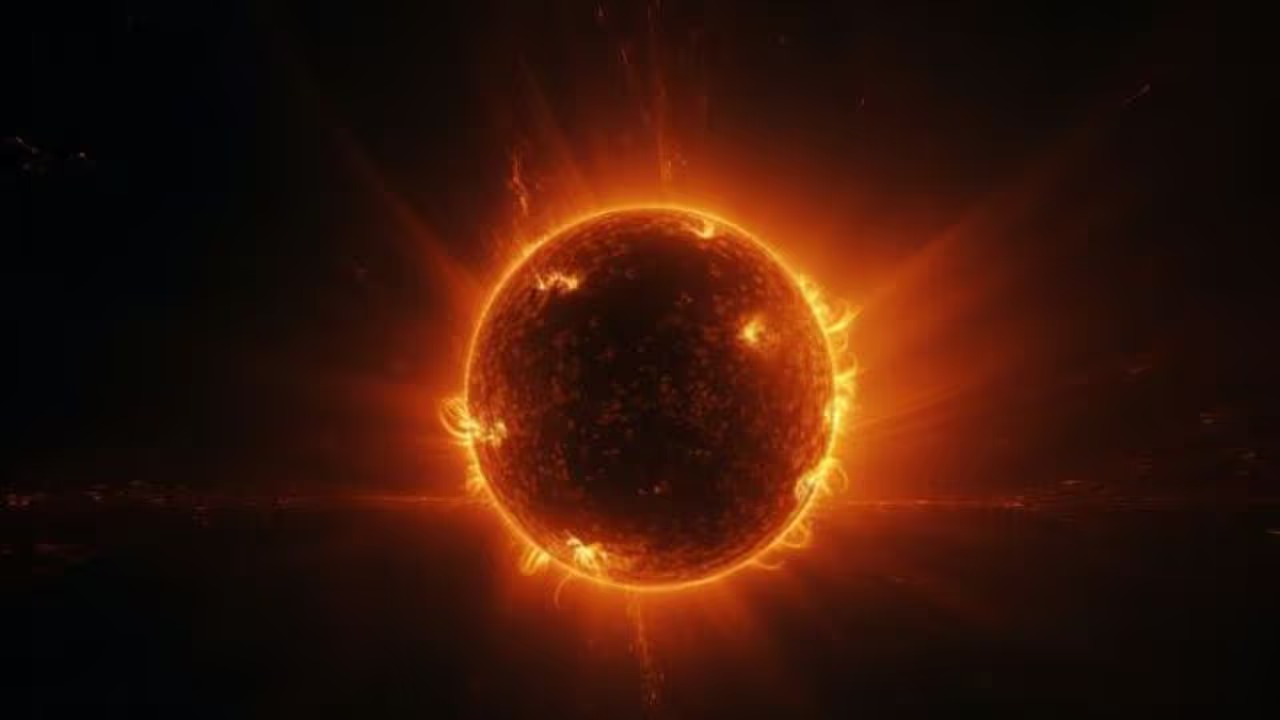Solar flares impact Earth, satellites, and astronauts. X-class flares are the strongest, potentially causing geomagnetic storms. A recent X2.8 flare, the strongest since 2017, affected shortwave radio. Solar radiation storms from flares pose risks to astronauts and satellites
Solar flares are enormous explosions on the sun that release intense energy in the form of electromagnetic radiation. They are categorized based on their intensity from strongest to weakest: X-class, M-class, C-class, B-class, and A-class. Solar flares happen when magnetic energy in the sun's atmosphere builds up and is suddenly released. They are connected to the solar cycle, which is a pattern of solar activity that occurs roughly every 11 years and is influenced by the sun's magnetic field.

The sun's surface is a tangled mess of magnetic fields. The Sun's surface, called the Photosphere, is a hot layer emitting light and heat. It has granules and sunspots, and its temperature is about 5,500 degrees Celsius. Above it are the chromosphere and corona, forming the solar atmosphere with unique features. Electrically charged gases in the Sun generate magnetic fields, forming a magnetic dynamo (or magnetic generator). The turbulent nature of these gases causes the magnetic fields to twist and tangle. This dynamic magnetic behaviour, termed solar activity, can lead to eruptions like solar flares.
These eruptions release a large amount of electromagnetic radiation, including radio waves, microwaves, X-rays, gamma rays, and visible light. Solar flares are categorized into five classes based on the intensity of X-rays they emit. The assigned letter for each class indicates a 10-fold rise in energy output, akin to how the Richter scale gauges earthquake strength.
X-class flares stand out as the strongest solar flares. Next are M-class flares, which are 10 times less powerful than X-class. Following in decreasing order are C-class, B-class, and A-class flares, with A-class being too feeble to have a notable impact on Earth. Various kinds of flares, specifically those classified as X-class, impact Earth, satellites, and even astronauts.
Fortunately, the most prevalent solar flares, A and B-class, are the weakest and too feeble to have a notable impact on Earth. C-flares are also relatively weak, showing minimal or no effect on our planet. Just with the two largest flare classes, things become more interesting.
Powerful M-class and X-class flares have the potential to initiate coronal mass ejections, a significant release of plasma and magnetic field from the sun. This activity can disturb Earth's magnetosphere, leading to geomagnetic storms.
Geomagnetic storms can cause auroras to appear nearer to the equator than they normally would under calm conditions. Auroras, also known as northern or southern lights, are dazzling natural light displays in the sky. They occur when charged particles from the sun interact with Earth's magnetic field, causing gases in the atmosphere to glow. These colourful lights are often seen in polar regions but can occasionally be observed closer to the equator during geomagnetic storms.
In 1989, a big burst of solar energy, along with a mass of charged particles, struck Earth. This event caused a power outage in the entire province of Quebec, Canada, lasting for 12 hours. Solar radiation storms release high-energy charged particles that pose a threat to astronauts and satellites in Earth's orbit. When these storms occur, astronauts on the International Space Station must find shelter, and spacewalks are put on hold. Satellite systems sensitive to radiation are turned off until the storm subsides.
Solar radiation storms originate from the sun's outer atmosphere, specifically from solar flares and coronal mass ejections (CMEs). These events release large amounts of charged particles, including protons and electrons, into space, creating the potential for solar radiation storms when these particles interact with Earth's magnetic field.
During a solar eruption, M-class and X-class flares can lead to disruptions in radio communication on the side of Earth facing the sun. These disturbances, known as radio blackouts, primarily impact High Frequency (HF) radio (3-30 MHz), although occasionally Very High Frequency (VHF) (30-300 MHz) and higher frequencies can also be affected.
On Thursday, December 14, the Sun emitted a powerful X-class solar flare, the most intense category. NASA reported that their Solar Dynamics Observatory captured an image of the event. The flare was labelled as X2.8, where X-class indicates high intensity, and the number specifies its strength. Solar flares and eruptions can affect radio communication, power grids, and navigation signals, and pose dangers to spacecraft and astronauts. The X2.8 peaked at 12:02 pm EST on Tuesday.
As per SpaceWeather.com, the X2.8 was the strongest solar flare since September 2017. The flare on Thursday resulted in a significant blackout for shortwave radio in the Americas. Thursday, the power we observed on those specific bands was nearly 10,000 times higher than the usual background radiation from the sun says Space weather.com
Even though the flare was strong, it wasn't directly aimed at Earth but slightly off, suggesting a possible glancing impact or no impact at all. Ongoing analysis indicates that if it does reach us, it's anticipated around December 17, potentially causing a mild geomagnetic storm, as per the UK Met Office.
